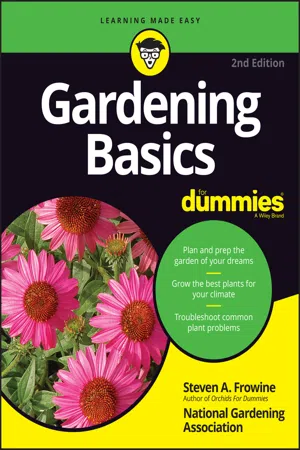
Gardening Basics For Dummies
Steven A. Frowine
- English
- ePUB (adapté aux mobiles)
- Disponible sur iOS et Android
Gardening Basics For Dummies
Steven A. Frowine
À propos de ce livre
Cultivate your passion to grow
In a 1625 essay, Francis Bacon called gardens "the purest of human pleasures, " and what was true then is even more so today—gardening can give you a serene refuge from the short-lived (and noisy!) distractions of modern life and a fertile basis for satisfaction that will bear fruit long into the future. To help you get started on your own leafy paradise, the new edition of Gardening Basics For Dummies grounds you thoroughly in the fundamentals of soil, flowers, trees, and lawns—and helps you get to know the names of what you're planting along the way!
In a friendly, straightforward style, professional horticulturist Steven A. Frowine distills 50 years of gardening experience to show you how to start growing your expertise—from planning out your own mini-Eden and planting your first annuals, bulbs, and perennials through to laying the perfect lawn, raising tasty crops, and even introducing fish to your landscape! He also digs into the grubbier side of horticultural life, making sure you're as prepared as any seasoned farmer to deal with pests, weeds, and other challenges the earth will throw up at you.
- Create your ideal garden plan
- Become an expert on common flora with definitions and descriptions
- Know how to look after your soil
- Get creative with butterfly and children's gardens
Whether you're beginning with a tiny garden in a box, or beautifying your property with tree-lined groves and flowery bowers, this is the ideal introduction to the intense pleasure of gardening and will make you happy to reap what you've sown!
Foire aux questions
Informations
Preparing Yourself (and Your Garden) for Planting
Getting Ready for Gardening




Playing the Name Game
Getting used to plant nomenclature
Botanical names
- The species name: The species name is kind of like your own first name (except it comes last in a plant’s botanical name).
- The genus name: The genus name is similar to your family name (except in botanical names, it comes first).
Common names
Anatomy 101: Naming plant parts
Table des matières
- Cover
- Title Page
- Table of Contents
- Introduction
- Part 1: Preparing Yourself (and Your Garden) for Planting
- Part 2: Flowers and Foliage: Growing for Color
- Part 3: Stretching Your Garden beyond Its Boundaries: The Permanent Landscape
- Part 4: Producing Your Own Produce
- Part 5: Designing Special and Fun Gardens
- Part 6: The Part of Tens
- Appendix A: Basic Gardening Resources
- Appendix B: English-Metric Conversion Tables
- Index
- About the Author
- Advertisement Page
- Supplemental Images
- Connect with Dummies
- End User License Agreement

